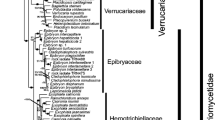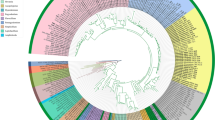Abstract
Omphalotaceae is the family of widely distributed and morphologically diverse marasmioid and gymnopoid agaric genera. Phylogenetic studies have included the family in Agaricales, grouping many traditionally and recently described genera of saprotrophic or parasitic mushroom-producing fungi. However, some genera in Omphalotaceae have not reached a stable concept that reflects monophyletic groups with identifiable morphological circumscription. This is the case of Gymnopus and Marasmiellus, which have been the target of two opposing views: (1) a more inclusive Gymnopus encompassing Marasmiellus, or (2) a more restricted Gymnopus (s. str.) while Marasmiellus remains a distict genus; both genera still await a more conclusive phylogenetic hypothesis coupled with morphological recognition. Furthermore, some new genera or undefined clades need more study. In the present paper, a phylogenetic study was conducted based on nrITS and nrLSU in single and multilocus analyses including members of the Omphalotaceae, more specifically of the genera belonging to the /letinuloid clade. The resulting trees support the view of a more restricted Gymnopus and a distinct Marasmiellus based on monophyletic and strongly supported clades on which their morphological circumscriptions and taxonomic treatments are proposed herein. The results also provide evidence for the description of two new genera: Paragymnopus and Pusillomyces. Pusillomyces manuripioides sp. nov. (type species of the genus) is described with morphological description, taxonomic and ecological remarks, and illustrations.








Similar content being viewed by others
References
Antonín V, Noordeloos ME (1997) A monograph of Marasmius, Collybia and related genera in Europe. Part 2: Collybia, Gymnopus, Rhodocollybia, Crinipellis, Chaetocalathus, and additions to Marasmiellus. Libri Botanici 17:1–256
Antonín V, Noordeloos ME (2010) A monograph of marasmioid and collybioid fungi in Europe. IHW-Verlag, Eching
Antonín V, Halling RE, Noordeloos ME (1997) Generic concepts within the groups of Marasmius and Collybia sensu lato. Mycotaxon 63:359–368
Antonín V, Ryoo R, Ka K-H (2014) Marasmioid and gymnopoid fungi of the Republic of Korea. 7. Gymnopus sect. Androsacei. Mycol Prog 13:703–718. https://doi.org/10.1007/s11557-013-0953-z
Berkeley MJ (1856) Decades of fungi. Decades LI - LIV. Rio Negro fungi. Hooker's J Bot Kew Gard Misc 8:129–144
Binder M, Hibbett DS (2002) Higher-level phylogenetic relationships of Homobasidiomycetes (mushroom-forming fungi) inferred from four rDNA regions. Mol Phylogenet Evol 22:76–90. https://doi.org/10.1006/mpev.2001.1043
César E, Bandala VM, Montoya L, Ramos A (2018) A new Gymnopus species with rhizomorphs and its record as nesting material by birds (Tyrannideae) in the subtropical cloud forest from eastern Mexico. MycoKeys 42:21–34. https://doi.org/10.3897/mycokeys.42.28894
Coimbra VRM, Pinheiro FGB, Wartchow F, Gibertoni TB (2015) Studies on Gymnopus sect. Impudicae (Omphalotaceae, Agaricales) from Northern Brazil: two new species and notes on G. montagnei. Mycol Prog 14:110. https://doi.org/10.1007/s11557-015-1131-2
Darriba D, Taboada GL, Doallo R, Posada D (2012) jModelTest 2: more models, new heuristics and parallel computing. Nat Methods 9:772. https://doi.org/10.1038/nmeth.2109
Dennis RWG (1961) Fungi venezuelani: IV, Agaricales. Kew Bull 15:67–156
Dentinger BTM, Gaya E, O’Brien H, Suz LM, Lachlan R, Díaz-Valderrama JR, Koch RA, Aime MC (2016) Tales from the crypt: genome mining from fungarium specimens improves resolution of the mushroom tree of life. Biol J Linn Soc 117:11–32. https://doi.org/10.1111/bij.12553
Desjardin DE, Gordon SA, Petersen RH (1993) Observations on two rhizomorph-forming species of Marasmiellus. Mycol Res 97:111–122. https://doi.org/10.1016/S0953-7562(09)81147-7
Dutta AK, Wilson AW, Antonín V, Acharya K (2015) Taxonomic and phylogenetic study on gymnopoid fungi from Eastern India. I. Mycol Prog 14:1–18. https://doi.org/10.1007/s11557-015-1094-3
Edgar RC (2004) MUSCLE: a multiple sequence alignment method with reduced time and space complexity. BMC Bioinform 5:113. https://doi.org/10.1186/1471-2105-5-113
Halling RE (1983) The genus Collybia (Agaricales) in the northeastern United States and adjacent Canada. Mycol Mem 8:1–148
Halling RE (1996) Notes on Collybia. V. Gymnopus section Levipedes in tropical South America with comments on Collybia. Brittonia 48:487–494. https://doi.org/10.2307/2807862
Hughes KW, Mather DA, Petersen RH (2010) A new genus to accommodate Gymnopus acervatus (Agaricales). Mycologia 102:1463–1478. https://doi.org/10.3852/09-318
Kämmerer A, Besl H, Bresinsky A (1985) Omphalotaceae fam. nov. und Paxillaceae, ein chemotaxonomischer Vergleich zweier Pilzfamilien der Boletales. Plant Syst Evol 150:101–118. https://doi.org/10.1007/BF00985571
Kearse M, Moir R, Wilson A, Stones-Havas S, Cheung M, Sturrock S, Buxton S, Cooper A, Markowitz S, Duran C, Thierer T, Ashton B, Meintjes P, Drummond A (2012) Geneious basic: an integrated and extendable desktop software platform for the organization and analysis of sequence data. Bioinformatics 28:1647–1649. https://doi.org/10.1093/bioinformatics/bts199
Kühner R (1933) Etudes sur le genre Marasmius. Botaniste 25:57–116
Kühner R (1980) Les hyménomycetes agaricoides (Agaricales, Tricholomatales, Pluteales, Russulales). Bull Soc Linn Lyon 49:1–1027
Küppers H (2002) Atlas de los colores. Editorial Blume, Barcelona
Mata JL, Petersen RH, Hughes KW (2001) The genus Lentinula in the Americas. Mycologia 93:1102–1112. https://doi.org/10.2307/3761671
Mata JL, Hughes KW, Petersen RH (2004a) Phylogenetic placement of Marasmiellus juniperinus. Mycoscience 45:214–221. https://doi.org/10.1007/S10267-004-0170-3
Mata JL, Halling RE, Hughes KW, Petersen RH (2004b) Rhodocollybia in neotropical montane forests. Mycol Prog 3:337–352. https://doi.org/10.1007/s11557-006-0104-x
Mata JL, Hughes KW, Petersen RH (2006) An investigation of /omphalotaceae (Fungi: Euagarics) with emphasis on the genus Gymnopus. Sydowia 58:191–189
Matheny PB, Curtis JM, Hofstetter V, Aime MC, Moncalvo J-M, Ge ZW, Yang ZL, Slot JC, Ammirati JF, Baroni TJ, Bougher NL, Hughes KW, Lodge DJ, Kerrigan RW, Seidl MT, Aanen DK, DeNitis M, Daniele GM, Desjardin DE, Kropp BR, Norvell LL, Parker A, Vellinga EC, Vilgalys R, Hibbett DS (2006) Major clades of Agaricales: a multilocus phylogenetic overview. Mycologia 98:984–997. https://doi.org/10.1080/15572536.2006.11832627
Moncalvo J-M, Lutzoni FM, Rehner SA, Johnson J, Vilgalys R (2000) Phylogenetic relationships of agaric fungi based on nuclear large subunit ribosomal DNA sequences. Syst Biol 49:278–305. https://doi.org/10.1093/sysbio/49.2.278
Moncalvo J-M, Vilgalys R, Redhead SA, Johnson JE, James TY, Aime MC, Hofstetter V, Verduin SJW, Larsson E, Baroni TJ, Thorn RG, Jacobsson S, Clémençon H, Miller OK Jr (2002) One hundred and seventeen clades of euagarics. Mol Phyl Evol 23:357–400. https://doi.org/10.1016/S1055-7903(02)00027-1
Murrill WA (1916) Agaricaceae Tribe Agariceae. N Am Flora 9:297–374
Nylander JAA (2004) Mr. Modeltest v2. Program distributed by the author. Evolutionary Biology Centre, Uppsala University, Uppsala, Sweden
Pegler DN (1983) The genus Lentinula (Tricholomataceae tribe Collybieae). Sydowia 36:227–239
Petersen RH, Hughes KW (2016) Micromphale sect. Perforantia (Agaricales, Basidiomycetes); expansion and phylogenetic placement. MycoKeys 18:1–122. https://doi.org/10.3897/mycokeys.18.10007
Petersen RH, Hughes KW (2017) An investigation on Mycetinis (Euagarics, Basidiomycota). MycoKeys 24:1–138. https://doi.org/10.3897/mycokeys.24.12846
Petersen RH, Hughes KW (2019) Two additional species of Gymnopus (Euagarics, Basidiomycotina). MycoKeys 45:1–24. https://doi.org/10.3897/mycokeys.45.29350
Retnowati A (2018) The species of Marasmiellus (Agaricales: Omphalotaceae) from Java and Bali. Gard Bull (Singapore) 70:191–258
Robert V, Vu D, Amor ABH, van de Wiele N, Brouwer C, Jabas B, Szoke S, Dridi A, Triki M, ben Daoud S, Chouchen O, Vaas L, de Cock A, Stalpers JA, Stalpers D, Verkley GJM, Groenewald M, dos Santos FB, Stegehuis G, Li W, Wu L, Zhang R, Ma J, Zhou M, Gorjón SP, Eurwilaichitr L, Ingsriswang S, Hansen K, Schoch C, Robbertse B, Irinyi L, Meyer W, Cardinali G, Hawksworth DL, Taylor JW, Crous PW (2013) MycoBank gearing up for new horizons. IMA Fungus 4:371–379. https://doi.org/10.5598/imafungus.2013.04.02.16
Ronquist F, Teslenko M, van der Mark P, Ayres D, Darling A, Höhna S, Larget B, Liu L, Suchard MA, Huelsenbeck JP (2012) MrBayes 3.2: efficient Bayesian phylogenetic inference and model choice across a large model space. Syst Biol 61:539–542. https://doi.org/10.1093/sysbio/sys029
Sandoval-Leiva PA, McDonald JV, Thorn RG (2016) Gymnopanella nothofagi, a new genus and species of gymnopoid fungi (Omphalotaceae) from Chilean Nothofagus forests. Mycologia 108:820–827. https://doi.org/10.3852/15-303
Singer R (1939) Phylogenie und Taxonomie der Agaricales. Schweiz Z Pilzk 17:71–73
Singer R (1960) Monographs of South American Basidiomycetes, especially those of the east slope of the Andes and Brazil. 3. Reduced marasmioid genera in South America. Sydowia 14:258–280
Singer R (1976) Marasmieae (Basidiomycetes – Tricholomataceae). Flora Neotrop Monogr 17:1–347
Singer R (1986) The Agaricales in modern taxonomy, 4th edn. Koeltz Scientific Books, Koenigstein
Stamatakis S (2006) RAxML-VI-HPC: maximum likelihood-based phylogenetic analyses with thousands of taxa and mixed models. Bioinformatics 22:2688–2690. https://doi.org/10.1093/bioinformatics/btl446
Vellinga EC, Kuyper TW, Ammirati J, Desjardin DE, Halling RE, Justo A, Læssøe T, Lebel T, Lodge DJ, Matheny BP, Methven AS, Moreau PA, Mueller GM, Noordeloos ME, Nuytinck J, Ovrebo CL, Verbeken A (2015) Six simple guidelines for introducing new genera of fungi. IMA Fungus 6:65–68
White TJ, Bruns TD, Lee S, Taylor J (1990) Amplification and direct sequencing of fungal ribosomal RNA genes for phylogenetics. In: Innis MA, Sninsky DH, White TJ (eds) PCR protocols: a guide to methods and applications. Academic Press Inc, New York, pp 315–322
Wilson AW, Desjardin E (2003) A phylogenetic analysis of the Gymnopus/ Marasmiellus complex using nLSU sequence data. Abstracts, Mycological Society of America 99
Wilson AW, Desjardin DE (2005) Phylogenetic relationships in the gymnopoid and marasmioid fungi (Basidiomycetes, euagarics clade). Mycologia 97:667–679. https://doi.org/10.1080/15572536.2006.11832797
Wilson AW, Desjardin DE, Horak E (2004) Agaricales of Indonesia. 5. The genus Gymnopus from Java and Bali. Sydowia 56:137–210
Acknowledgments
The authors thank the INPA Herbarium for contributing to this publication, R.H.S.F. Cruz for doing the illustrations, Dr. Tarciso de Sousa Filgueiras for reviewing the names in Latin, Dr. Genevieve Gates (Honorary Associate in Mycology and Forest Ecology, Tasmanian Institute of Agriculture) for reviewing the English writing and the anonymous reviewers for relevant contribution to this paper. The authors also thank the financial and logistical support from the Fundação de Amparo à Pesquisa do Estado do Amazonas – FAPEAM, the Centro de Estudos Integrados da Biodiversidade Amazônica (INCT-CENBAM), the Conselho Nacional de Desenvolvimento Científico e Tecnológico (CNPq), the Biodiversity Research Program (PPBio), and the Japan Science and Technology Agency /Japan International Cooperation Agency - Science and Technology Research Partnership for Sustainable Development (JST/JICA-SATREPS). Study registered in SISGen (Sistema Nacional de Gestão do Patrimônio Genético e do Conhecimento Tradicional Associado) number A44535D.
Funding
This study was supported by “Coordenação de Aperfeiçoamento de Pessoal de Nível Superior – CAPES” with a scholarship from “Programa Nacional de Pós-doutorado – PNPD” granted to J.J.S. de Oliveira, post-doctoral fellow of DIBOT, and other to T.S. Cabral, post-doctoral fellow of DIGEN, INPA. For R. Vargas-Isla, a scholarship from “Ação Orçamentária – MCTIC/PT 19.571.2021.20VD.0001 (C, T & I para Pesquisa, Desenvolvimento, Conservação, Valoração e Sustentabilidade dos Recursos Naturais Brasileiros).
Author information
Authors and Affiliations
Corresponding author
Additional information
Section Editor: Zhu-Liang Yang
Publisher’s note
Springer Nature remains neutral with regard to jurisdictional claims in published maps and institutional affiliations.
Electronic supplementary material
ESM 1
(PDF 2.83 mb)
Rights and permissions
About this article
Cite this article
Oliveira, J.J.S., Vargas-Isla, R., Cabral, T.S. et al. Progress on the phylogeny of the Omphalotaceae: Gymnopus s. str., Marasmiellus s. str., Paragymnopus gen. nov. and Pusillomyces gen. nov.. Mycol Progress 18, 713–739 (2019). https://doi.org/10.1007/s11557-019-01483-5
Received:
Revised:
Accepted:
Published:
Issue Date:
DOI: https://doi.org/10.1007/s11557-019-01483-5




